Round Hill Crescent
After reading this page, try the Round Hill Crescent quiz
See the Round Hill Crescent section on pages 50-57 of the proposed update for Round Hill's conservation character statement:
When the houses were built
c1865 1-13 Round Hill Crescent Grade II listed
c1865 19-21 Round Hill Crescent Grade II listed
c1865 23-27 Round Hill Crescent Grade II listed
c1865 69 & 71 Round Hill Crescent Grade II listed
c1865 101-113 Round Hill Crescent Grade II listed
1871 94 & 96 Round Hill Crescent.
1877 80-92 Round Hill Crescent.
1878 18-28 Round Hill Crescent.
1879 68-86 Round Hill Crescent.
1880 73 & 75 and 81-91 Round Hill Crescent.
1883 58 Round Hill Crescent.
1883 73 - 77 Round Hill Crescent.
1885 38, 40, 42 & 44 Round Hill Crescent.
1895 39 - 57 Round Hill Crescent.
1897 36 Round Hill Crescent.
1897 17 Round Hill Crescent.
1901 30 Round Hill Crescent.
Introduction
The Crescent contains the only listed buildings in the Round Hill conservation area. These buildings are stuccoed, lined out to represent ashlar, and each house has a highly decorative cast iron balcony on the first floor. They represent the last appearance of the Regency style in Brighton.
The Wikipedia entry for Roundhill Crescent usefully identifies five groups of houses built in the mid 1860s. under the heading ARCHITECTURE.
These are also identified by Historic England which offers further descriptions in its listings, marking locations on its maps using very small blue triangles.-----Nos.1-13-----Nos.19 & 21-----Nos.23-27-----Nos.69 & 71-----Nos.101-113-----The latter are the current house numbers.
Between the listed buildings are further terraced houses of the late 1870s and 1880s, of a similar height and bulk although their roofs have bracketed eaves rather than a parapet to the street.
The street was re-numbered in 1881 when there were homes on both sides and it was possible to use ODDS on the north side and EVENS on the south side.
EXAMPLE: 44, 45, 46, 47, 48, 49 on the north side (just east of the junction with D'Aubigny Road) become 101, 103, 105, 107, 109, 111 and 113 (an extra one). There has been further renumbering (employing alphabetical letter) after homes have been divided into flats.
Round Hill Crescent is notable for the way in which it both curves and changes height dramatically along its length with continuous terraces of houses on either side. At the south-western end, the road ascends steeply, gracefully curving to the right as it changes levels.
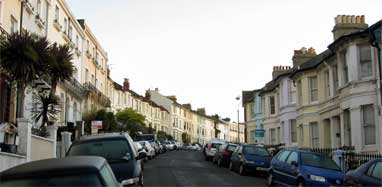
It then descends sharply towards the north-eastern end, meeting the junction with the Upper Lewes Road. The majority of buildings in the area feature render and boast a strong vertical emphasis. The later houses on the Crescent are characterised by canted bays at the front and adorned with moulded string courses.
On the south/east side of the road, the houses are smaller and more varied in their detailing, with some original dormers set in pitched roofs facing the street, sometimes ending in a gable. There are two 19th century cast iron street lamps, outside no. 62 and at the bottom of the twitten from Wakefield Road. Negative features include the many slated roofs recovered in concrete tiles, the insertion of unsympathetic dormers and other modern windows, and the replacement of traditional panelled doors with off-the-shelf modern reproductions; alterations carried out under 'permitted development' rights prior to the introduction of the Round Hill Article 4 Direction and its more restrictive planning controls in the year 2000.
The buildings on the northwestern side are three storeys tall, including a basement, while those on the lower southeastern side have two storeys along with a basement. In between the listed buildings are further terraced houses from the late 1870s and 1880s, which share a similar height and bulk but have bracketed eaves instead of a parapet facing the street.
The development of Roundhill Crescent began in 1865, featuring regency-style terraced houses with iron balconies at either end. A second building phase took place in the 1880s, including the surrounding streets.
An 1865 masterplan revealed the symmetrical layout of D’Aubigny Road and Lennox Road, both radiating north from Round Hill Crescent. However, Ashdown Road was not included in this plan. Historical maps from 1855 show Lennox Road laid out in accordance with the masterplan. At some point, it was deemed too steep for horse-drawn vehicles and subsequently converted into a narrow staircase called 'The Cats creep.' By 1900, Lennox Road had been renamed Lennox Passage, and though the original street sign is lost, it is suggested that the name and sign be reinstated.
Among the known residents of Round Hill Crescent is John IZARD, residing at 31 Round Hill Crescent. Head of the household at No 31, he was also Agent to the Conservative Land Society doing work for the Round Hill Estate Office which was selling parcels of land from the Round Hill Park Estate to people looking for properties in Round Hill to live in or as investments. He was also a collector for a water company.
You will also find his name in the Pages 1871 street directory. A Brighton street directory 1878 clarifies that his wife, Susanna, offers private tuition.
The Post Office Directory of Sussex 1878 shows 17 households in Round Hill Crescent.
According to an 1859 street directory, Round Hill Crescent had only six occupied households on the north side at each end: specifically, numbers 4, 5, 8, 9, 12 (west end), and 45 and 49 (east end).
Streetscape
There are no local listed lamp posts in Roundhill Crescent. The only surviving historic lamp post sits opposite Nos. 101-113 Roundhill Crescent (Listed Grade II List Entry No: 1380837) at the crescent’s start (or end). It is also associated with the two villas on the east side of the crescent designed to mark the beginning of the terrace.
Brighton’s local listing criteria include lampposts in planned formal crescents. This fulfils the Council criteria for local listing except that it does not form part of a group of columns. Type 2 columns are more typically found in Hove. The Council appraisal claims this type was designed as an electric lamp column, although there seems some doubt that this applies here.
[1]1-13 (odd) Roundhill Crescent (north side)
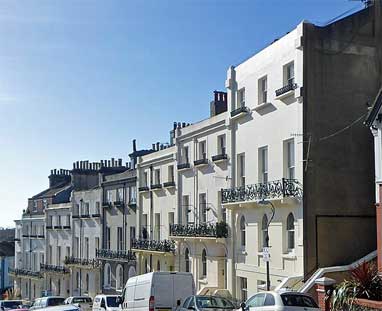
<
Each house has a three-window range and is separated from its neighbour by pilasters running the full height of the building to a cornice. Common features of the listed houses include stuccoed façades carved to look like ashlar, ornate cast-iron balconies and cast iron railings separating them from the pavement.
The 1859 street guide and directory shows no. 5 Roundhill Crescent as being owned by Mr J. Coppinger whose son Walter Arthur Copinger (1847-1910) was an English professor of law and a barrister remembered for writing the standard legal reference work on Copyright: Copinger and Skone James on Copyright.
See Historic England's listing (designated 2 March 1981) of properties later numbered as ODDS with alphabetical letters for different flats.
Annuitant* (7), Candle Maker (retired), Captain M S (Retired), Clerk, Domestic servant (10), General Servant (2), Governess, Income arising from Dividends, Inland Revenue Office, Nonconformist Minister, Physician (Retired), Retired Builder, Retired Schoolmaster, Scholar (11) Servant (Domestic) (2), Student (2), Student of The Inner Temple
* Possibly somebody on an annual allowance or receiving an annual income frrom investment. Also used for institutionalized pensioners.
An 1859 street directory shows Roundhill Crescent with just 6 occupied households on the north side at each end: numbers 4, 5, 8, 9, 12 (west end) 45 and 49 (east end). It shows No 5 as being owned by Mr J. Coppinger whose son Walter Arthur Copinger (1847-1910) was a barrister remembered for writing the standard legal reference work on Copyright: Copinger and Skone James on Copyright.
[2] 2- 16 (even) Roundhill Crescent (south side)
The presence of basements on the downhill side has meant that many of the houses have retained their attractive cast iron railings with spear heads but all of these buildings sit right on the pavement with no garden space to any of them. Of note are the simple sash windows which have either one or two panes in each sash.
Original dormers set in pitched roofs facing the street, sometimes ending in a gable.
[3] 17 Roundhill Crescent
Red (gabled terracotta-walled) house and cats creep
17 was added when the plan for Lennox Road was abandoned in favour of steps.
A red brick and plain tile-faced detached villa infilled the gap on Roundhill Crescent from the late 1890s.

[4] 19-21 (odd) Listed Grade II built c1865
To the east of Lennox Road (The Cats Creep)
See Historic England's listing (designated 2 March 1981) of properties now numbered as ODDS (19, 21).
No mention here of occupations.
Note that during the 1860s, the alley (now the Cats `creep) was a road, so the gabled terracotta walled house appears later. A gap remains in its place for some time. Although it was already clear that the steep Lennox Road was not viable for carriages, planning permission for the steps to what became Lennox Passage was granted in 1900.
The flank elevation of No. 19 is dressed and detailed to face the abandoned road (more clearly seen on the south flank of 101 Roundhill Crescent- facing D’Aubigny Road).
[5] Nos.23-27
Moving further eastwards (past the telephone box), see Historic England's listing (designated 2 March 1981) of properties now numbered as ODDS (23-27). They can be identified by the papapets on the roofs. Although they go unmentioned in the 1871 census, they were built in the mid 1860s as the listing mentions.
[6] 18- 28 (even) Roundhill Crescent (south side).
These houses date from 1878. They were built by Spreadborough and German. Hector German (1852-1933) built houses in several other Round Hill streets.
[7] 30 Roundhill Crescent (south side) Red house
This house dates from 1901 and was built by Trower and Burstow. Bustow & Bustow also built the red house at No.17 by the entrance to the Cats Creep.
[8] 32-34 (even) Roundhill Crescent (south side) Infill
[9] 36-44 (even) Roundhill Crescent (south side)
No. 36 dates from May 1897 and was built by Towner and Parnacott. William Parnacott (1856-1921) had several occupations including surveyor, architect, house and estate agent, auctioneer, rate and tax collector.
James Towner is recorded in the 1871 population census as a builder, aged 41, living at 14 Lewes Road. The 1891 census has him living at 1 D’Aubigny Road.
Together with Samuel Denman (1855-1945) architect and surveyor, James Towner built 38, 40, 42 and 44 Roundhill Crescent.
[10] 46-54 (even) Roundhill Crescent (south side)
Mid crescent on (south side)
[11] 56 Roundhill Crescent (south side) Infill
[12] 58- 94 (even) Roundhill Crescent (south side)
No.58 dates from February 1883 and was built by Stenning and Denman. In 1881, the building firm of W.A. & J Stenning is quoted as employing 42 men and 5 boys.
Nos. 68-86 date from July 1879 and were built by Towner and Denman.
Nos. 80-92 date from October 1877 and were built by Scrase and Dallimore
Nos. 94 and 96 date from November 1871 and were built by Bennett and Simpson.
[13] Nos 23-27 (odd) Roundhill Crescent (north side)
Nos 23-27 Listed Grade II
These grade II listed houses, built c1865, have two windows on each floor. All retain their original features, but some of the decorative mouldings have been modified on three of the buildings.
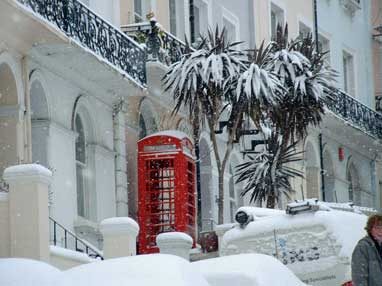
[14] 29-49 (odd) Roundhill Crescent (north side) 31 was the Round Hill Estate Office (1871)
39-57 date from April 1895 and were built by Richardson and Nye. Charles Nye (1852-1923) was an architect, surveyor and civil engineer, whose work was prolific, though mainly in Hove.
[15] 51-67 (odd) Roundhill Crescent (north side) Three storey terraces and centre
[16] Nos.69 & 71 (odd) Roundhill Crescent
Middle pair of Grade II listed buildings built c1865)
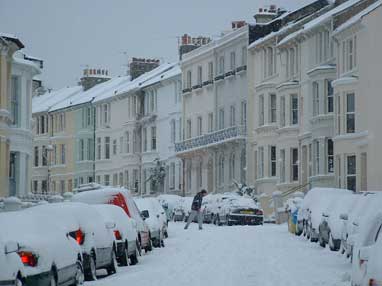
Numbers 69 and 71 are again of three storeys with a three-window range, stucco-clad and topped by a cornice and parapet in front of the roof.As with the other 1860s houses, they both have first-floor balconies with foliage-pattern ironwork.
[17] 73-79 (odd) Roundhill Crescent (north side)
East Sussex Record Office show 73 and 75 and 81-91 (8 houses) as being built by Scrace and German in 1880. However, their records also show 73-77 (3 houses) as being built by Stenning and Denman in 1883.
[18] 81-99 (odd) Roundhill Crescent (north side)
Corner between Ashdown and D’Aubigny
[19] Nos.101-113 (odd) Roundhill Crescent (north side)
Nos 101-113 built c1865 are listed Grade II

The seven houses at numbers 101–113 also have three windows to each of three storeys. 101 was the Lewes Road Hospital for Women and Children (aka Lady Chichester Hospital), replacing a dispensary in Islingword Road, from 1905 until it moved to 8 Ditchling Road in 1910. The 12-bed hospital was the first in England for the treatment of mental illness. Prior to that, people were sent to lunatic asylums and received little treatment.
[20] 115-123 (odd) Roundhill Crescent (north side)
Beyond 123 Roundhill Crescent is the junction with Upper Lewes Road.
See Historic England's listing (designated 2 March 1981) of properties now numbered as ODDS (101, 103, 105, 107, 109, 111, 113)
Jobs: Annuitants (4), Captain (6th Dragoons / Inniskillings), Cook, Domestic servant (5), Governess (2), Housemaid, Interest On Money (2), Ladies’ School, Nurse (2), Scholar (8), Teacher
Note that teaching is an occupation which is opening up for women, especially in Brighton (which became to be known as "school city") and in the more affluent streets. The 1882 street directory shows 109 Roundhill Crescent (formerly No 48 before the street was re-numbered in 1881) as a boarding and day school run by Mrs Stephenson and Miss Walker.
Long views
The long views, which are most precious to Brighton & Hove, are those into the conservation area from public vantage points such as Warren Road (near Brighton Racecourse) Tenantry Down and Woodvale. Roundhill Crescent runs across the centre of the photo below in the form of an arc, which is backed by a green ribbon of gardens and privately owned open space. This green ribbon and the green segments below and above it, help the conservation area’s Victorian architecture to stand out. The original plan has remained remarkably intact.
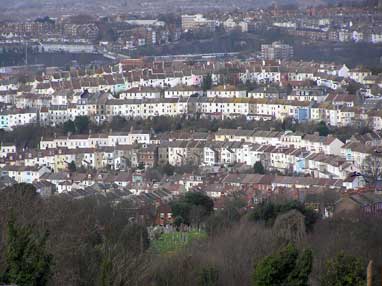
Roundhill Crescent can be seen below the wide green ribbon to the left.
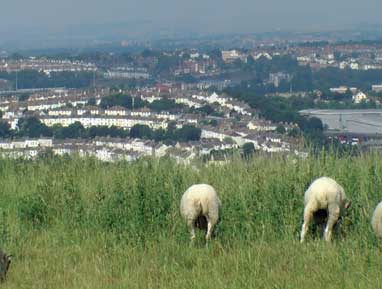
Occupations in Roundhill Crescent
Among the early occupants of Roundhill Crescent were several annuitants, people living from interest on money, a captain of 6th Dragoons /Inniskillings, a governess and a teacher as well as a cook and several domestic servants. Teaching was an occupation which was opening up for women, especially in Brighton (which became to be known as “school city”) and in the more affluent streets. The 1882 street guide and directory shows 109 Roundhill Crescent as a boarding school run by Mrs Stephenson and Miss Walker. Many women’s occupations were home-based such as “laundress” or “dressmaker”, though these relate more to the poorer streets to the north of Round Hill. The 1891 census shows 39 people in Roundhill Crescent living from “Private means or income”. Few are recorded as “pensioners”, though the adjective “retired + occupation” is recorded in a number of cases. There is even a “retired common traveller”. There are 23 “Domestic” or “General” Servants. There are very few laundresses, as exist further up in Round Hill where drying conditions are probably better and people are generally less well off: a mere two households. No. 58 Roundhill Crescent houses two laundresses and one laundress’s assistant while no.76 has one laundress and one ironer.
General comments and comparisons
In addition to the following list, there are 39 people living from "Private means or income". These are frequently the heads of households. Many are of pensionable age. Few are recorded in the census as "pensioners", though the adjective "retired + occupation" is recorded in a number of cases. There is even a retired common traveller.
There are 23 "Domestic" or "General" Servants.
Note within the list that there are very few laundresses [as exist further up Round Hill where drying conditions are probably better and people are generally less well off]. A mere two households in Roundhill Crescent:
58 Roundhill Crescent offers two laundresses and one laundress's assistant. At No. 76, there is one laundress and one ironer. That's all. The population is generally older i.e. many of retirement age with adult sons and daughters living in the same households.
Roundhill Crescent contributes to the description of Brighton as "School Town". Below the comprehensive list is a section on this.
List of Jobs: numbers 1 to 111 Roundhill Crescent
Cheesemonger, Dentist, Boot and shoe maker, Dressmaker, Engine Cleaner, Cabman, Dressmaker (aged 12), Surgeon, Journalist Newspaper Manager, Heraldic Engraver, Pianoforte Teacher, Signal Porter Railway, Retired Coachman, Congregational Minister, School Mistress, Booksellers Assistant, School Mistress, School Mistress, Coal Merchants Clerk, Retired Military Officer, Water Rate Clerk, Dressmaker, Mantle Shaw Apprentice, Dressmaker, Drapers Assistant, Dental Pupil, Telegraphist, Dressmaker, Grocers Assistant, Drapers Assistant, Laundress, Ironer, Furniture Salesman, Clerk China Glass, Manager of Fish Shop, Mantle Maker, General Carriers Clerk, Post Office Sorting Clerk, Teacher, Fitter Engine Apprentice, Sign Writer / Painter, Home Assistant, Sign Writer / Painter, Carpenter, Boarding House Keeper, Upholsterer, Board School Teacher, Board School Teacher, Lithographic Artist, Tailoress Apprentice, Insurance Agent, Bank Clerk, Retired Wine Merchant, Drapers Assistant, Contractor, Milliner, Dressmaker, Milliner, Ladies Outfitting, Milliner, Milliner, Government Contractors Agent, Army Scripture Reader, Assistant School Mistress, Clerk, News Proprietor, Assistant Town Hall Staff, Money Taker North Road Baths, Governess, Retired Common Traveller, Post Office Telegraphist, Inspector of Groynes, Teacher of Music, Captain, Retired Broker, Lieutenant Corporal 4th Dragoons, Soldier 6th Dragoons, Coal Merchant, Coal Merchant, Coal Merchant, Monumental Mason, Housekeeper, Pharmaceutical Student, Joiner, Visiting Governess, Professor of Music, Housekeeper, Agent Singer’s Sewing Machine.
Schools and Teachers in Roundhill Crescent
The 1891 Street Directory Nos 1 to 40---Nos 42 to 109 shows an Assistant H.M. Inspector of Schools (no 11), two Elementary School Mistresses and a Teacher of Swedish drill (no 23), a young ladies school run by Miss Reed (no 27), a Certified School Mistress (no 34), an Assistant School Mistress and a Pupil Teacher (No 37), a Preparatory Day School run by Miss Edwards (no 44), Board School Teacher*** (no 59), Pianoforte Teacher (No 66), 3 Schoolmistresses (69) , Teacher (No 81), School Mistress (No 84), two Board School Teachers*** (No 85), Preparatory School run by Assistant School Mistress Miss Houghton (No 93), Teacher of Music (101), Professor of Music (111).
In several cases, the teachers are the daughters of the heads of households and are aged in their twenties.
*** BOARD SCHOOLS
Wikipedia:The Elementary Education Act 1880 (the "Mundella Act") required school boards to enforce compulsory attendance from 5 to 10 years, and permitted them to set a standard which children were required to reach before they could be employed.
101 Roundhill Crescent
in 1891
Streatham House
In 1891, 101 Roundhill Crescent on the junction with D'Aubigny Road, was called Streatham House and was occupied by a family who came from London. The head, Mr Henry Whelpdale (aged 72 and born in Grays Inn) was living on private means.
He and his wife, Mary Ann (aged 67 and born in Battersea) had four daughters, the three youngest of whom were born in Streatham! The only occupation given is for the second youngest daughter (aged 29), who works as a Teacher of Music.
1905 -1910
Lewes Road Hospital for Women and Children
In February 1905, a 7-year lease was acquired at £50 per annum at No.101 Roundhill Crescent (at the junction with D'Aubigny Road). This was for a pioneer enterprise, initially called the Lewes Road Hospital for Women and Children. It is described in Wikipedia as "the first hospital for the treatment of mental illness". As with Lady Chichester Hospital, it was closely associated with Doctor Helen Boyle who was a specialist in this field.
Rear of 101 Roundhill Crescent as viewed from D'Aubigny Road
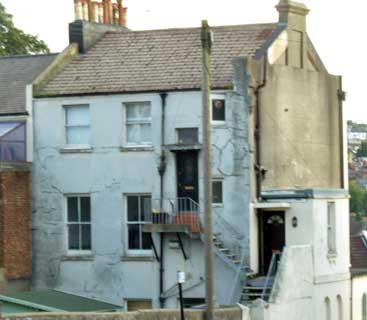
No 101 Roundhill Crescent also housed the dispensary which had been at 145 Islingword Road since 31st October 1899. It is hoped that the Round Hill building will shortly receive a blue plaque to go with Historic England's listing of No. 101.
Helen Boyle and her work in Brighton
The terminology used in census records in the latter part of the 19th century reveals social attitudes towards mental health: "Lunatic" - someone who is mentally ill, though at times lucid; "Imbecile" - usually applied to later life in cases of chronic dementia; "Idiot" - usually applied to mental deficiency from birth.
- There is a mine of information on The Lady Chichester at THE KEEP. The case histories are mainly post 1920s, but there is a link which opens out under "administrative history" which gives an account of The Lewes Road Dispensary for Women and Children and the hospital in Round Hill
Click here for an extraordinary overview - Women's Hospitals in Brighton and Hove by Val Brown extends to the work of Doctors Mabel Jones and Louisa Martindale as well as the work of Helen Boyle.
“School City” and Roundhill Crescent (1891 Census)
Education is well represented with an Assistant H.M. Inspector of schools at no.11, two Elementary School Mistresses and a Teacher of Swedish drill at no. 23, a young ladies’ school run by Miss Reed at no. 27, a Certified School Mistress at no.34, an Assistant School Mistress and a Pupil Teacher at no.37, a Preparatory Day School run by Miss Edwards at no.44, a Board School Teacher at no.59, a Pianoforte Teacher at no.66, three Schoolmistresses at no.69, a Teacher at no. 81, a School Mistress at no. 84, two Board School Teachers at no 85., a Preparatory School run by Assistant School Mistress Miss Houghton at no. 93, a Teacher of Music at no. 101 and a Professor of Music at no.111. This expansion in educational interest can partly be credited to “Board Schools”. The Elementary Education Act of 1880 (known as the “Mundella Act”) required school boards to enforce compulsory attendance from 5 to 10 years, and permitted them to set a standard which children were required to reach before they could be employed.
Today, the division of the larger households in Roundhill Crescent into flats (some purchased and some rented out) has removed disparities of income according to street, though the proximity and growth of the universities of Brighton and Sussex mean that many occupations in Round Hill are education-related.
Female employment
The article (below) indicates that in 1871 it wasn't fashionable for women to work. Roundhill Crescent was also a fairly wealthy street with many residents receiving income from invesments.
Read the excellent article The Missing Half: Female employment in Victorian England and Wales [PDF] by Dr Xuesheng You
Towards the end of the 19th century and the turn to the 20th century, occupations open up for women, though many are home-based e.g. laundress and dressmaker and relate to the poorer streets to the north of Round Hill further out from the town centre. There were doubtless many women working as dressmakers in the absence of all the large department stores which came later. Some local history sites mention that the title of "dressmaker" was occasionally used as a cover by women offering services which one would not want to declare in a population census, but this footnote should not be used to discredit an occupation which was widespread before so much of our clothing was factory made.
Women like the doctors Mabel Jones and Louisa Martindale and Helen Boyle were breaking new ground as women doctors, opening up new opportunities by example. As noted in relation to 109 Roundhill Crescent in 1882 (formerly No 48) teaching was also opening up as an occupation for women.
Front façade of 101-113 Roundhill Crescent

There are musicians at both ends of the terrace: 101 and 111
FREE CEN
Practise using the Census data site e.g. study of Roundhill Crescent in 1871
- At http://www.freecen.org.uk complete these fields ONLY:
- Surname: Izard
- First name: John
- Census County: Sussex
- Census Place: Brighton
- Census Year: 1871
- Click the SEARCH button
- Select for all the information
- Continue viewing data for more households in the same street (or one nearby) by clicking the or buttons
You will gather data on everybody living in Roundhill Crescent in 1871, including servants.
A known resident is John IZARD of 31 Round Hill Cres (born in Sussex). He was a collector for a water company, but also played a part in selling plots on The Round Hill Park Estate for the Conservative Land Society.
Another is Georgiana F GURMARVENS of 6 Round Hill Cres (born in Kent).
Practise using the Census data site e.g. study of Roundhill Crescent
- At http://www.freecen.org.uk complete these fields ONLY:
- Surname: Pritchett
- First name: Louisa
- Census County: Sussex
- Census Place: Brighton
- Census Year: 1891
- Click the SEARCH button
- Select for all the information
- A known resident is Louisa PRITCHETT of 1 Roundhill Cres (born in Gloucestershire)
Another is Charles John CROSSLEY of 21 Roundhill Cres (born in Sussex).
Another is Joseph ALLFREY of 22 Roundhill Cres (born in Sussex)
The lets you fill in the street name. Take care to shorten "Roundhill Crescent or Round Hill Crescent" to "Round Hill Cres" (as above). The birth county is optional.
Round Hill history texts
Ashdown Road | Belton Road | Crescent Road | D'Aubigny Road | Ditchling Road | Lennox Passage (The Cats Creep) | Mayo Road | Princes Crescent | Princes Road | Richmond Road | Round Hill Crescent | Round Hill Road | Round Hill Street | Wakefield Road